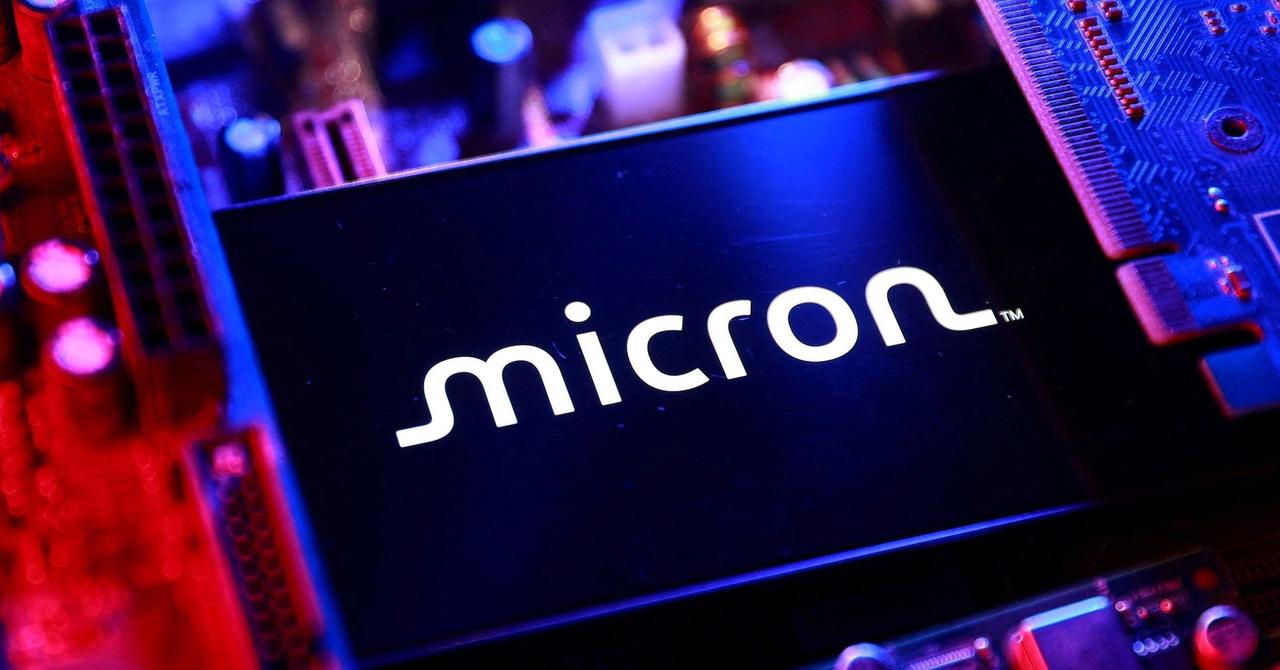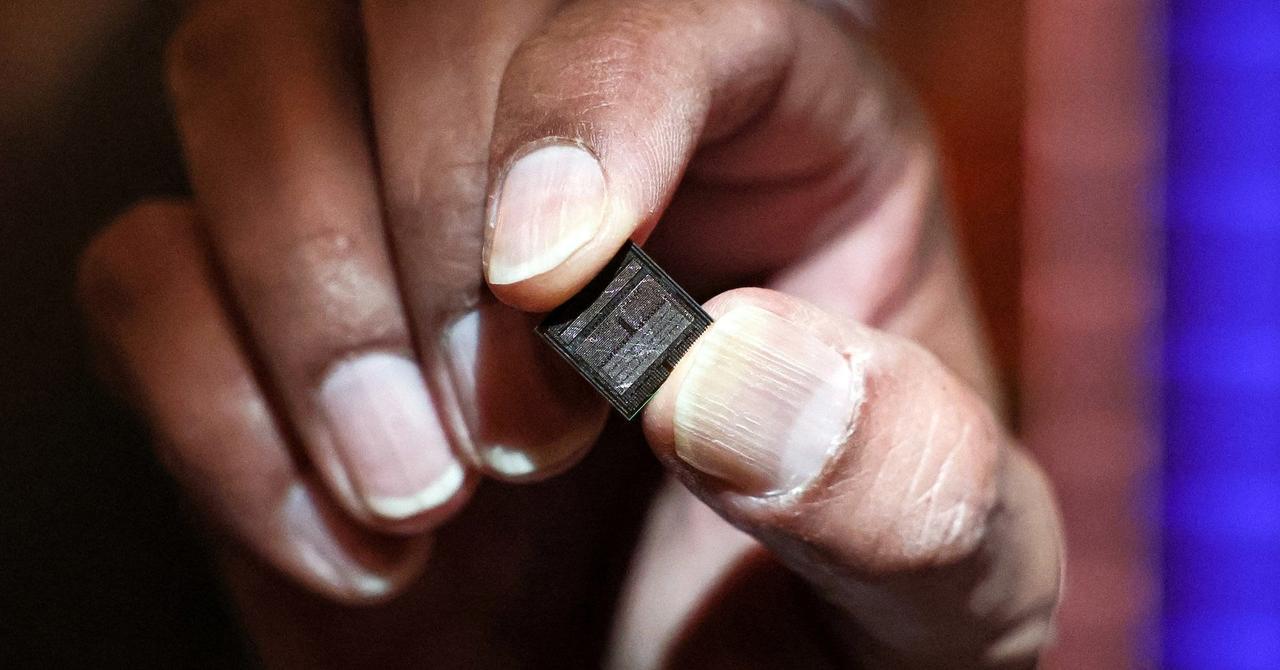Micron's Record-Breaking Quarter Signals Strong AI Demand in Memory Chip Market
9 Sources
9 Sources
[1]
Micron forecasts first-quarter revenue above estimates on AI demand
Sept 23 (Reuters) - Micron Technology (MU.O), opens new tab forecast first-quarter revenue above market estimates on Tuesday, betting on booming demand for artificial intelligence hardware to boost sales of its advanced memory chips. Shares of the memory chip maker rose 4% in extended trading. The race to build the most sophisticated AI models and expand the data center infrastructure that they run on has boosted demand for Micron's high-bandwidth memory chips, or HBM. Micron supplies HBM for some of AI chip leader Nvidia's (NVDA.O), opens new tab semiconductors, which dominate the lucrative AI accelerator market. Much of the competition among the world's largest memory suppliers -- Micron, SK Hynix (000660.KS), opens new tab and Samsung (005930.KS), opens new tab -- has centered on becoming a key supplier to Nvidia, owing to the world's most valuable company's dominant market position. Micron forecast first-quarter sales of $12.50 billion, plus or minus $300 million, compared with the analysts' average estimate of $11.94 billion, according to data compiled by LSEG. The company reported revenue of $11.32 billion for the fourth quarter, beating estimates of $11.22 billion. Reporting by Arsheeya Bajwa in Bengaluru; Editing by Alan Barona Our Standards: The Thomson Reuters Trust Principles., opens new tab
[2]
Micron beats on earnings as company sales rise 46% on AI boom
A person walks by a sign for Micron Technology headquarters in San Jose, California, on June 25, 2025. Micron reported better-than-expected earnings and revenue on Tuesday as well as a robust forecast for the current quarter. The stock rose in extended trading. Here's how the company did in comparison with the LSEG consensus: Micron said revenue in the current period, its fiscal first quarter, will be about $12.5 billion, versus the $11.94 billion average analyst estimate per LSEG. The company said it had $3.2 billion, or $2.83 per share in net income, versus $887 million, or 79 cents in the year-ago period. Micron shares have nearly doubled so far in 2025. The company makes memory and storage, which are important components for computers. Micron has been one of the winners of the artificial intelligence boom. That's because high-end AI chips like those made by Nvidia require increasing amounts of high-tech memory called high-bandwidth memory, which Micron makes. "As the only U.S.-based memory manufacturer, Micron is uniquely positioned to capitalize on the AI opportunity ahead," Micron CEO Sanjay Mehrotra said in a statement. Overall company revenue rose 46% on a year-over-year basis during the quarter. Micron's largest unit, which sells memory for cloud providers, reported $4.54 billion in sales during the quarter, more than tripling on a year-over-year basis. However, the company's core data center business unit saw sales decline 22% on an annual basis to $1.57 billion in revenue.
[3]
Micron beats expectations again on soaring AI memory chip demand - SiliconANGLE
Micron beats expectations again on soaring AI memory chip demand Memory chip maker Micron Technology Inc. reported strong fourth-quarter earnings and revenue today and followed with guidance that came in well ahead of expectations, sending its stock higher in extended trading. The company reported earnings before certain costs such as stock compensation of $3.03 per share, cruising past Wall Street's target of $2.86 per share, and up from just $1.18 in the year-ago period. Revenue for the quarter hit $11.3 billion, up 46% from a year ago and edging past the analyst consensus estimate of $11.2 billion. Last month, Micron took the unusual step of increasing its fourth-quarter earnings and revenue guidance - something that's rarely done by publicly traded companies half-way through the quarter. Today's results exceeded those recently-raised expectations. The strong numbers helped Micron's bottom line surge, with net income rising to $3.2 billion, up from just $887 million in the year-ago period. Micron also offered solid guidance for the current quarter. It said it's expecting fiscal 2026 first quarter sales of around $12.5 billion at the midpoint of its range, above the Street's target of $11.9 billion. And it sees earnings of between $3.60 and $3.90 per share, far in excess of the analyst's $3.05 target. Micron's stock was up just over 1% after-hours, adding to momentum that has seen it almost double in value in the year to date. The company is a supplier of memory and storage chips, and sells these vital components to both server and personal computer makers. The company has emerged as one of the big winners of the artificial intelligence boom due to soaring sales of its high-bandwidth memory chips, which are essential for AI servers powered by graphics processing units. On a conference call with analysts, Micron Chief Executive Sanjay Mehrotra (pictured) said the company enjoys a unique position as the only U.S.-based manufacturer of HBM chips, which gives it a golden opportunity to capitalize on future AI growth. The company's cloud memory business unit, which accounts for AI memory chip sales, delivered $4.54 billion in sales during the quarter, more than tripling year-over-year. The mobile and client business unit added another $3.76 billion in sales, up 18%, while the automotive and embedded business delivered $1.43 billion, up 16%. The only disappointment was Micron's core data center unit, where sales declined 22% from a year earlier to $1.57 billion. "We have strong momentum entering fiscal 2026, with a robust fiscal Q1 demand outlook led by data center, and the most competitive position in our history," Mehrotra told analysts. "Over the coming years, we expect trillions of dollars to be invested in AI, and a significant portion will be spent on memory." In response to a question from an analyst during the call, Mehrotra said the supply of dynamic random-access memory remains very tight due to the increased demand from the AI sector. He also reiterated that the company's next generation HBM4 memory chips are still on track to support customers ramping up their chip platforms, even though the bandwidth and performance requirements of many have increased. According to Mehrotra, the company recently shipped its first samples of HBM4 to customers, adding that they boast an industry-leading bandwidth of 2.8 terabytes per second, with "pin speeds" exceeding 11 gigabytes per second, referring to the data transfer rates that each pin on the memory module can achieve. The executive conceded that the specifications of HBM chips are becoming "more demanding", but said the company believes it's in a good position with its next generation of products, and expects that its value proposition will continue to grow. Micron is in something of uncharted territory, with the AI boom upending traditional expectations for chipmakers. Typically, the business was always characterized by dramatic swings in market demand, inventories and pricing, resulting in cyclical fluctuations in revenue and earnings growth. However, investors hope that the insatiable demand for memory chips from companies building AI data centers will offset any weaknesses elsewhere in Micron's other segments, such as chips for consumer devices. It has currently been growing solidly for the last two years, which is already longer than most cycles, but investors would be very disappointed if it suddenly came to a halt now, and expect it to continue growing for some time yet. In a note to clients, TD Cowen analyst Krish Sankar said he expects memory chip prices to grow over the next three-to-four quarters. Ordinarily, this deep into an up cycle, inventories would become inflated, causing prices to drop and a downward cycle to begin, he said. But he doesn't believe that will happen yet. "We think Micron stock will continue its outperformance in the short term as checks continue to support that momentum," Sankar said.
[4]
Why Micron's Record Sales and Strong Outlook Are a Bullish Signal for the AI Trade
Its outlook for the current quarter also topped estimates, offering another strong signal of AI demand. Micron Technology (MU) shares climbed in extended trading Tuesday after the memory chip maker posted record quarterly sales, boosted by surging demand for AI hardware. The Nvidia (NVDA) and Advanced Micro Devices (AMD) partner's shares were up over 2% in after-hours trading. They've nearly doubled in value in 2025 through Tuesday's close. The memory chip maker reported adjusted earnings per share of $3.03 on revenue that jumped 46% year-over-year to a record $11.32 billion in its fiscal fourth quarter. Both figures topped analysts' estimates compiled by Visible Alpha as Micron's data center business grew. "In fiscal 2025, we achieved all-time highs across our data center business and are entering fiscal 2026 with strong momentum and our most competitive portfolio to date. As the only U.S.-based memory manufacturer, Micron is uniquely positioned to capitalize on the AI opportunity ahead," said CEO Sanjay Mehrotra. Looking ahead, Micron said it expects adjusted earnings per share of $3.41 to $3.71 on revenue of $12.20 billion to $12.80 billion in the fiscal first quarter, ahead of consensus projections.
[5]
Micron CEO Says 'AI Is The Driver Of Our Growth' - Micron Technology (NASDAQ:MU)
Micron Technology, Inc. MU analyst estimates on the top and bottom lines in the fourth quarter, and CEO Sanjay Mehrotra attributed the growth to AI-related demand. MU stock is moving. See all the details here. Mehrotra described fiscal 2025 as a "record-breaking year," and highlighted the company's leadership in high-bandwidth memory and DRAM, as well as its strong position entering fiscal 2026. Read Next: Rigetti, D-Wave, IonQ Set To Disrupt Everything -- Expert Goes All In AI Drives Growth Not only did Micron beat estimates for the fourth quarter, the company also guided for first quarter revenue of $12.5 billion, plus or minus $300 million, versus estimates of $11.93 billion, according to Benzinga Pro. Micron said it expects first-quarter adjusted earnings of $3.60 to $3.90 per share versus estimates of $3.04 per share. Mehrotra said on the company's earnings call that he expects trillions of dollars to be invested in AI over the coming years. The CEO explained that memory is central to AI, in an interview with CNBC on Wednesday. He added that Micron's growth was fueled by demand from AI data centers, which accounted for more than 50% of revenue for the year. "Over the next several years there will be trillions of dollars invested in AI and memory will actually benefit from that as well. Memory will be a significant portion of that investment," Mehrotra said. He added that Micron is well-positioned in other markets outside of data centers, including AI-enabled phones and AI PCs. "AI is the driver of our growth," Mehrotra said. Read Next: Opendoor Stock Jumps As Jane Street Grabs 5.9% Stake Photo: Shutterstock MUMicron Technology Inc$161.30-3.07%OverviewMarket News and Data brought to you by Benzinga APIs
[6]
Micron's AI Memory Chip Business Is Booming | The Motley Fool
Memory chip manufacturer Micron (MU -2.83%) was slow to embrace the high-bandwidth memory (HBM) chip market. HBM is critical for artificial intelligence accelerators, providing the massive bandwidth necessary to run AI workloads effectively. In the early days of the AI boom, Micron was largely missing in action. That situation has now changed dramatically. Micron has successfully ramped up production of HBM chips and is pushing ahead with development of its next-generation HBM4. As manufacturers prioritize HBM, demand is outstripping supply for standard DRAM chips, leading to strong pricing. These two factors have led to blockbuster results for Micron. The memory chip market is cyclical, owing to the commodity nature of memory chips. It's possible that the current up cycle would have already ended if not for the AI boom. Demand for PCs and smartphones isn't particularly strong, with both markets weakening considerably following pandemic-era booms. But AI has turned everything on its head. Manufacturers are racing to increase the supply of HBM as hundred-billion-dollar AI infrastructure deals are thrown around like candy. This prioritization of HBM over standard DRAM is pressuring DRAM supply, pushing up prices. Not only is Micron selling massive quantities of high-priced HBM chips, but it's benefiting from rising DRAM pricing as well. Micron's total revenue in the fourth quarter of fiscal 2205 was $11.3 billion, up 46% year over year. About four-fifths of that total came from DRAM, which includes HBM. Revenue from HBM alone was nearly $2 billion in the quarter, putting HBM revenue at an $8 billion annual revenue run rate. It wasn't long ago that Micron's HBM revenue rounded down to zero, so this is quite an accomplishment. For standard DRAM, Micron expects to grow its bit supply for calendar 2025 at a lower rate than industry bit demand. Combined with improving demand and constrained supply growth from other suppliers, the company expects DRAM supply growth to remain muted going into 2026, which should put upward pressure on pricing. Micron's profit margins are exploding under these conditions. Adjusted gross margin was 46% in the fourth quarter, and adjusted operating margin was 35%. Both metrics were up significantly year over year. For the first quarter of fiscal 2026, Micron sees adjusted gross margin expanded to a range of 50.5% to 52.5%. Historically, it's been rare for Micron's GAAP gross margin to exceed 40%. GAAP gross margin was only slightly lower than non-GAAP gross margin in the fourth quarter, easily topping that level. As long as demand for AI infrastructure, and in turn demand for HBM, continues to boom, Micron will be sitting pretty. Major AI infrastructure deals are popping up seemingly every day. OpenAI reportedly agreed to pay Oracle $300 billion over five years for AI infrastructure, then took a $100 billion investment over time from GPU giant Nvidia to fund AI infrastructure investments. Other tech giants, including Microsoft and Meta, are also pouring unprecedented amounts of capital into AI data centers. For the time being, demand for HBM looks likely to accelerate as these AI infrastructure investments play out. However, it's not hard to see where all this might be heading. These investments are based on assumptions about future demand for AI computing, as well as future capabilities of AI models and agents. If that demand doesn't materialize or comes up short of expectations, one eventual consequence would be a vast oversupply of HBM chips. Under this scenario, the extremely strong up cycle Micron currently finds itself in would give way to a potentially brutal down cycle. Micron has reported negative gross margins during the worst down cycles of the past as prices fell off a cliff. The next down cycle could be just as bad. Of course, it's impossible to predict anything about the AI industry multiple years into the future. However, investors thinking about buying Micron stock should remember that memory chip up cycles have never lasted forever.
[7]
Micron signals higher HBM4 share and DRAM-focused $18B CapEx through 2026 as AI data center demand accelerates (NASDAQ:MU)
Earnings Call Insights: Micron Technology, Inc. (MU) Q4 2025 Management View * CEO Sanjay Mehrotra was referenced during the call but did not provide direct remarks; key business updates were provided by Sumit Sadana, Executive VP & Chief Business Officer. Sadana indicated the company expects "the large Micron expects to gain higher HBM share, matching or exceeding its DRAM supply share, leveraging its strong competitive position in data center SSDs and ramp in high-value memory as AI-driven demand accelerates. The $18 billion CapEx will mainly support DRAM construction and equipment, suggesting heightened future capacity and innovation in DRAM to address market tightness and capitalize on robust AI and hyperscaler demand. Exiting managed NAND allows Micron to reallocate supply to tighter, higher-margin data center markets; ongoing supply constraints and improved pricing should further bolster gross margins and profitability.
[8]
Micron CEO Says Next-Gen Computer Memory Coming In 2026, Expects Demand Surge: 'We Will Be At The Forefront...' - NVIDIA (NASDAQ:NVDA), Micron Technology (NASDAQ:MU)
On Tuesday, Micron Technology Inc. MU said that its next generation of high-speed computer memory will launch in 2026. The company's current chips are already fueling Nvidia Corporation's NVDA most advanced artificial intelligence systems. Micron shares rose 1.09% on Tuesday and added another 0.43% in after-hours trading, according to Benzinga Pro. Micron CEO Outlines HBM4 Timeline On the company's fourth-quarter earnings call, Micron CEO Sanjay Mehrotra said the firm will begin shipping its new HBM4 memory in the second quarter of 2026, with production ramping up in the second half of the year. "We will be at the forefront of this production ramp, very much aligned with customers' timing," Mehrotra said, describing the product as an industry leader in both speed and efficiency. He added that Micron expects its share of the memory market to grow in 2026 as demand continues to surge. See Also: Apple Inc. Emphasizes Design Commitment Amidst High-Profile Exits Current Chips Power Nvidia's AI Supercomputers Micron's current HBM3E products are already built into Nvidia's Hopper and Blackwell platforms, the backbone of many AI data centers. These chips help boost performance for demanding AI workloads such as training large language models. The company also supplies SOCAMM modules, a new type of memory created in collaboration with Nvidia, designed for the Grace Blackwell Ultra Superchip. "Supply is tight. We expect a healthy demand-supply environment in 2026," Mehrotra said, noting that this backdrop should support strong profitability for Micron's broader memory business. Micron's Strong Q4 Quarterly Results Micron reported fourth-quarter revenue of $11.32 billion, topping Wall Street expectations of $11.22 billion. Adjusted earnings came in at $3.03 per share, ahead of analyst estimates of $2.86. Revenue rose 46% year-over-year, while operating cash flow reached $5.73 billion. The company generated $803 million of free cash flow during the quarter. Looking ahead, Micron sees first-quarter revenue of $12.5 billion, plus or minus $300 million, and expects adjusted earnings of $3.75 per share, plus or minus 15 cents. Both figures are well above analyst estimates. Benzinga's Edge Stock Rankings show that MU continues to trend higher across short, medium and long-term horizons, with more performance insights available here. Read Next: Apple May See Fewer Searches In Safari, But Google CEO Sundar Pichai Insists AI Is Fueling Overall Query Growth: 'Far From A Zero-Sum Game' Disclaimer: This content was partially produced with the help of AI tools and was reviewed and published by Benzinga editors. Photo: Poetra.RH / Shutterstock MUMicron Technology Inc$167.131.53%OverviewNVDANVIDIA Corp$177.92-3.10%Market News and Data brought to you by Benzinga APIs
[9]
Micron edges higher after outlook eclipses estimates on AI data center demand (MU:NASDAQ)
Micron Technology (NASDAQ:MU) edged up during early post-market trading Tuesday after the company reported its fourth quarter fiscal 2025 financial results. Artificial intelligence data center growth propelled revenue well past estimates, and the company expects to increase its revenue by more AI data center growth increased Micron's revenue and drove earnings past analyst estimates for the recent quarter. Micron forecasts next quarter's revenue and EPS significantly above market estimates, projecting $12.2B-$12.8B in revenue and $3.60-$3.90 in EPS versus lower consensus numbers. Micron's gross margins have risen substantially, expected to surpass 50% next quarter, enhancing its competitiveness as a U.S.-based memory manufacturer capitalizing on AI opportunities.
Share
Share
Copy Link
Micron Technology reports stellar Q4 earnings, beating expectations with a 46% revenue increase. The company's success is largely attributed to the booming demand for AI-related memory chips, positioning Micron as a key player in the AI hardware market.
Micron's Record-Breaking Performance
Micron Technology, a leading memory chip manufacturer, reported exceptional fourth-quarter earnings for fiscal year 2025, significantly surpassing market expectations. Revenue surged 46% year-over-year, reaching a record $11.32 billion
1
2
. This impressive growth is primarily attributed to surging demand for artificial intelligence (AI) hardware, especially high-bandwidth memory (HBM) chips.
Source: Seeking Alpha
AI-Driven Growth and Strategic Position
Micron's CEO, Sanjay Mehrotra, highlighted the company's unique position as the sole U.S.-based memory manufacturer, poised to "capitalize on the AI opportunity ahead"
2
. The cloud memory business unit, including AI chip sales, tripled its revenue year-over-year to $4.54 billion3
. Micron supplies HBM for NVIDIA's AI accelerators, a key success factor amid the AI boom1
.
Source: SiliconANGLE
Future Outlook and Technological Edge
The company projects robust revenue of approximately $12.5 billion for Q1 FY2026, exceeding analysts' estimates
1
4
. This optimistic forecast reinforces Micron's market standing in the AI trade. Micron has also shipped its first HBM4 memory chip samples, offering industry-leading bandwidth of 2.8 terabytes per second3
. This innovation underscores commitment to advanced memory for demanding AI applications.
Source: Reuters
Related Stories
Market Implications and Long-term Vision
Micron's stock has nearly doubled in 2025 due to strong performance and positive outlook
2
. Analysts anticipate continued memory chip price growth for the next three to four quarters, defying typical semiconductor cycles3
. Mehrotra foresees trillions of dollars invested in AI, with memory solutions playing a central role. He affirmed, "AI is the driver of our growth," emphasizing its importance across data centers, AI-enabled phones, and AI PCs5
.References
Summarized by
Navi
Related Stories
Micron Technology Raises Q4 Forecast Amid Surging AI-Driven Demand for Memory Chips
11 Aug 2025•Business and Economy

Micron's AI-Driven Revenue Surge Overshadowed by Margin Concerns
21 Mar 2025•Business and Economy

Micron's Stock Soars on Strong AI-Driven Forecast, Fueling Chip Industry Rally
26 Sept 2024








